Cracks in Drywall: 5 Steps to a Permanent Fix with 3M Patch Plus Primer
Do you have a crack in your drywall that keeps coming back?
Today’s post will help you fix this annoying problem in 5 easy steps using 3M’s Patch Plus Primer.
This weekend I was cleaning out the guinea pig cage that sits in our living room (did you know guinea pigs can live from 5 to 8 years, what the!!!) and noticed a crack in our wall under the window.
Apparently the previous homeowners tried to fix it since there was evidence of old joint compound around the crack.
Dealing with old rental homes has taught me a thing or two about drywall and plaster. After reading this post I guarantee you’ll be able to permanently fix any drywall crack in no time.
(I’ve included affiliate links for your convenience. I earn a small percentage from a purchase using these links. There is no additional cost to you. You can read more about affiliate links here.)
Materials:
- Fiberglass mesh drywall tape
- 3M Patch Plus Primer
- Putty knife
- 6 inch drywall knife
- Joint compound mud pan
- Sanding sponge
- Towel for your floor
- Your wall paint
- 2 to 3 episodes of Big Bang Theory
That’s not a bad supply list. My grocery list puts it to shame and is far more expensive (and that’s without buying Dogfish Head IPA beer).
Let’s get started and eliminate your cracked drywall 🙂
Instructions:
Step 1: Apply Fiberglass Mesh Tape to Your Drywall Crack
One of the biggest mistakes anyone can make is to just add joint compound or spackling to the drywall crack. Over time the crack will come back because the compound or spackling will never win the fight between it and your house settling. It’s like Pee Wee Herman challenging Mike Tyson.
Adding fiberglass mesh drywall tape to the crack is like giving Pee Wee anabolic steroids.
Center the tape on the crack. Since one side is sticky you can place it on the wall and get your Patch Plus Primer ready.
Step 2: Add a Thin Coat of Patch Plus Primer to the Drywall Tape
3M Patch Plus Primer is great for repairing cracks or holes in drywall because it doesn’t require a primer coat like traditional joint compound. So you save time and money 🙂
Big Tip: when you buy 3M Patch Plus Primer at the hardware store make sure it hasn’t been opened. Otherwise, it might be bad and unusable. The same principle applies to any product that comes in a container (including pre-mixed joint compound).
Apply a thin coat of Patch Plus Primer over your mesh tape. Just enough to fill the voids and make the tape adhere even more to the wall.
If your crack is long (say 2-5 feet) I recommend applying the patch plus primer to the tape with a 6 inch drywall knife. To do this, you’ll have to scoop some of the Patch Plus Primer into a mud pan to use the larger knife.
Add the spackling by starting in the middle of the tape. Spread the spackling on the tape in a downward motion from the center. Then go back and add the rest of the spackling moving upward from the center of the tape.
This stretches the tape along the crack and prevents it from wrinkling.
Allow this coat to dry for 30 minutes and watch 1 episode of Big Bang Theory.
Step 3: Add Your Second Coat of Patch Plus Primer
The reason for the light coat of 3M Patch Plus Primer in Step 1 is so you don’t have a big hump on your wall where the tape is located.
Use your 6 inch knife to put on a second coat of the Patch Plus Primer.
Make the width of the new coat be two inches to the right and 2 inches left of the center of the tape.
Then smooth out the spackling with your 6 inch drywall knife like you did in Step 2 (always starting in the center and moving toward the ends).
The key tip I have here is to apply slightly more pressure on the side of the knife that touches the drywall. This pressure change will feather the Patch Plus Primer and blend it into the existing drywall.
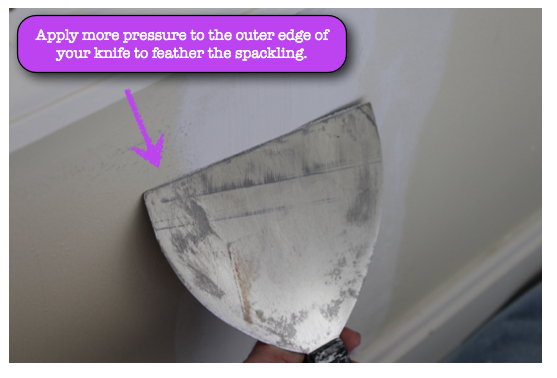 Depending on your skill and how perfect you want the wall you may have to apply a 3rd coat.
Depending on your skill and how perfect you want the wall you may have to apply a 3rd coat.
Step 4: Lightly Sand the Patch Plus Primer
For small drywall repair jobs I like to use a fine grit sanding sponge to feather the edges of spackling or joint compound. Lightly move the sanding sponge in a circular motion over the patched area. Circular motions will help blend the patch into the drywall.
It will take a well trained eye to notice where you made your repair.
Step 5: Paint Your Wall
The best part about the 3M Patch Plus Primer is that you don’t have to prime it.
Patch Plus Primer can be painted over after 30 minutes. Use a good quality paint brush or roller. I’ve been using a Purdy 2 inch brush for 2 years now and while the handle is rusted, the bristles look fantastic. I always rinse my brush in warm water then wrap it in Glad Press N Seal. Brittany also has a great tutorial on keeping your paint brushes looking new.
The wall looks pretty darn good, wouldn’t you say?
I’m gonna go out on a limb here but I think even Dr. Evil would be pleased with this job.
Now you know the secret to permanently fixing a drywall crack. This entire project can be done in one afternoon or over the weekend without breaking a sweat.
Stick around for a while! We have a lot more home and auto fixes and repairs for you:

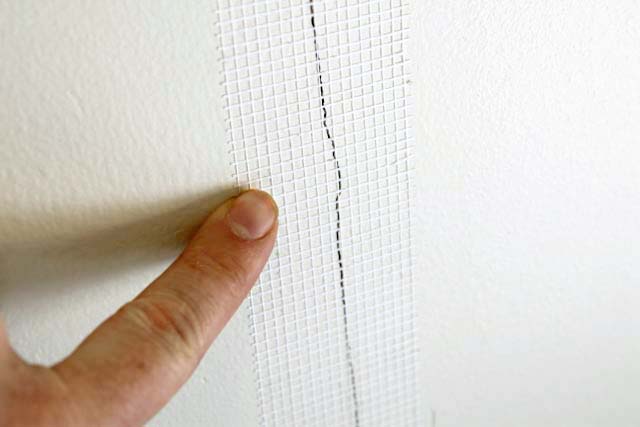
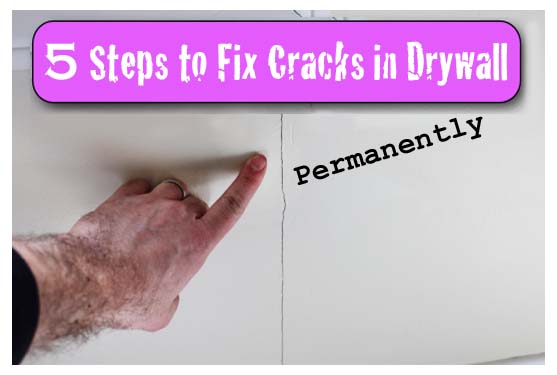

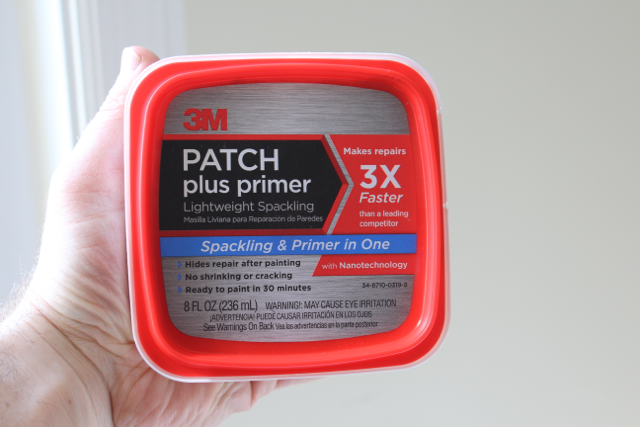

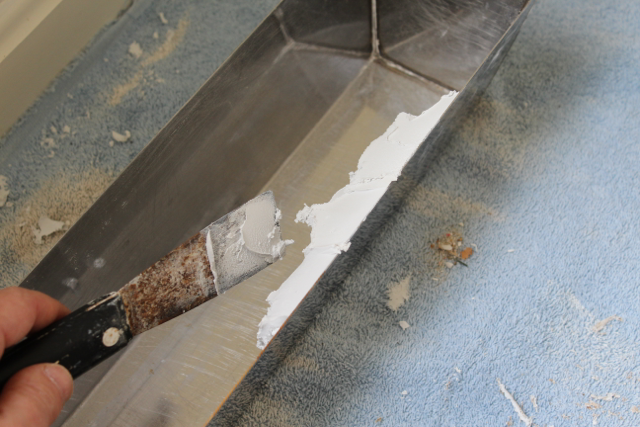
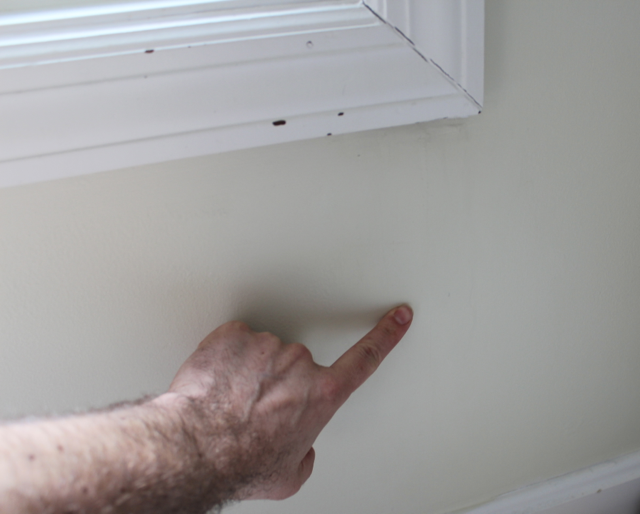



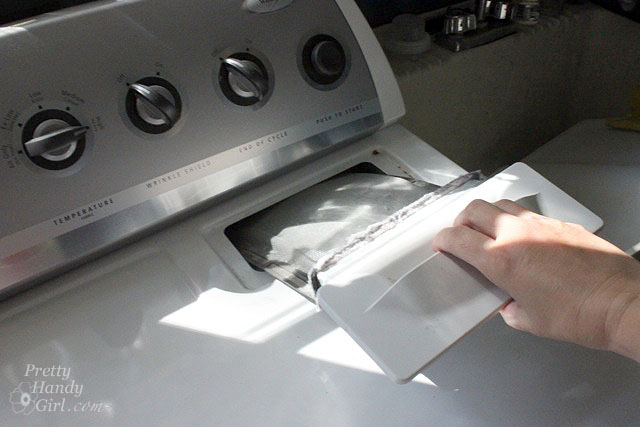



Does this technique work for corner cracks?
You could try this method Steven and if it doesn’t work then you could use the mesh tape. Definitely get a sealant that is paintable. Keep us posted on your progress 😀
I have a similar issue like Steven has (1/30/2015) with the vaulted corner of my house (master bathroom) that has cracks around the paper sheetrock tape even though we’ve re-done it twice. I think it’s both a combination of heating and cooling expansion because its exposed to the ceiling attic above it and the steam from showers, etc. I don’t think it’s settling because we have tile floors in the bathroom and nothing is showing signs of cracking, etc. either in the tile grout seams on the floor or the walls which have a lot of tiling on them.
I’m concerned that just using the mesh tape won’t be enough with the expansion/contraction and am interested in the elastomeric sealant treatment possibly. I was thinking of doing the sealant treatment with a waterproof, paintable application into the underlying crack to get some flex in the space (and eliminate water penetration in the future) but would I use that with a mesh tape over it or just the sealant by itself?
I am assuming I need to pull down the old tape which is separating along its edges from the ceiling, applying the sealant and then using the mesh tape and compound over the sealant as the replacement tape and finished surface? Not sure 1) this is overkill and 2) the mesh tape and compound will adhere to the sealant?
Any help is much appreciated.
We have also a similar situation. We are in the upper Midwest the change in weather extremes seems to made for us more cracks than I want to count! I was told by a painting professional that for recurrent cracks the answer it a non silicone elastomeric sealant gun put into the cracks that is paintable. then compound over it then sanded and painted. Have you heard of using that type of material it is squirted in or squeezed in like done in a bathroom seal but paintable. We have also a horizontal crack to deal with the first time ever this year like the commenter above mentioned.
Thanks.
I have had a crack in my hallway wall for several years. it bulged out. I don’t know if this is a butted seam. There is paneling under the sheetrock so it may have just popped out. I tried to cover the crack by putting spackling over the crack but it didn’t cover it. I would like to use the above method but was wondering if I needed to completely sand the spackling off first?
Shirley, you probably will need to sand the spackle down to get the wall smooth. Depending on the bulging you might need to add some extra screws to pull the sheetrock back flush against the wall. Or just live with the bulge. It’s hard for me to tell what’s going on without a picture.
Hi Brittany, thanks so much for your response. Just another quick question, if the cracks are only showing up in the winter, do you think that is still from the house settling. The house is about 45 years old, we have only been in it for 5 years. If I want someone to come look at the cracks and tell me for sure why they are showing up would I contact a home inspector?
Hello, I have a question. We keep getting expansion cracks within the last few years. The cracks seem to be showing on corners of inside walls in the house. The cracks show where the wall meets the ceiling. Do you have any suggestions on how to get this fixed? Is there anything we can do in the attic to prevent the cracks from coming back?
Taylor, do you have a crawlspace or poor drainage around your home? I’m thinking the cracks may be more from settling than an attic issue. There should be drywall tape that is folded in the corner where the ceiling meets the wall. If you have a newer home I wonder if that wasn’t done. I’d probably put a thin line of caulk in the corner (assuming your ceiling is white and you use white caulk.) The caulk with flex a little with any movement. But, in the meantime, make sure you don’t have any grading or drainage issues.
Hey recently remodeled and the contractor said that where the new sheetrock ceiling meets the old plaster ceiling that he would be able to make the look perfect………….. well…………. it has a crack… go figure. right!
SO has anyone dealt with trying to connect sheetrock to plaster? THoughts on solution?
I am confused where the spackling is coming from as it isn’t in the “grocery list” -add the spackling by starting in the middle of the tape…. are you still referring to the patch plus primer? So, in reality you have three coats?
Suzanne, yes, the Patch Plus Primer is like the name brand. It is a type of spackling. So, he used the term interchangeably ;-).
Very helpful. One question. When you say “start in the center [of the tape] and move toward the ends” do you mean from the center toward the edges of the tape as you apply the mud or do you mean from the bottom to the top of the crack/tape? All new to me. Thank you.
Wilson, start at the center of the tape (from top to bottom) work your way down toward the ground first and then up toward the ceiling. Hope that helps.
I have a drywall patching question – can you use a steel and mesh patch for a hole in drywall from where a new light fixture was installed? I just wasn’t sure if the steel part was ok, or if I need all fiberglass. The hole is big enough to need a patch, rather than just tape. Thanks!
Karen, your light fixture should be encased in a junction box. And hopefully the electrician (or installer) attached the wire nuts securely and wrapped them with electrical tape for good measure. But, as long as the mesh is outside the junction box, you should be fine. If you are concerned, you could put some dryway tape around the edge that is near the junction box.
Hi Marchia,
Thanks for your question, what is wallpaper sizing? Is it the paper portion or is it some other material?
The wallpaper I’m used to has a vinyl top portion and paper bottom. I try to remove all the paper with a steamer (costs about $50) and scrape all the glue off the wall.
If there’s any unevenness on the drywall or plaster I like to use setting type joint compound to smooth it out. I use a 6 inch joint compound knife for small repairs and a 10 inch knife if the entire wall is in bad shape.
Please let me know if this helps or if you’ve got more questions 😉
Jeff,
This is not about repairing cracks, but I need to paint my walls. The only problem is that there is wallpaper sizing on the walls that has been overlapped when it was applied. Will I need to skim coat the walls or will two coats of latex enamel cover up the overlaps? All the glue has been removed. Can I sandpaper the overlaps to remove them?
Need your advice!!
Marchia, I think your best course is to sand down the sizing to get it even. If you have any imperfections remaining, then you need to patch it with the 3M Patch Plus Primer. Then I would definitely 100% prime your walls before you paint. You don’t want the sizing to prevent your paint from sticking or to change the sheen.
Hello,
I can really use some advice here. I started noticing several cracks in my dry walled basement ceiling and more and more keep popping out every day. It is because the guy who hung the drywall was in experienced come to find out and did not stagger the seams. The finish guy did the best that he could do at the time and when it was finished painted it looks horrible.
I am stuck now because many people are saying that I cannot fix these cracks because they will just keep coming back! i want to possibly cover the whole thing up with a knockdown textured ceiling but i am afraid that I will be wasting my money because it will all come back again.
Another suggestion i got was to re-drywall over the existing and finish the correct way!
Another option would be to go drop ceiling and leave existing cracked drywall that had been painted where it is. Go drop ceiling over the drywall ceiling to cover up.
All seem pretty pricey..Any Ideas Please?
Mike
Sorry to hear about your ceiling Mike. That stinks.
If I were you I’d drywall over the existing ceiling or tear it down. Whatever you choose make sure to find the joists and use 3 inch long coarse drywall screws. That way your screws will definitely keep the drywall tight with the joist and eliminate movement.
Use setting-type joint compound because it’s stronger than the pre-mixed. And embed drywall tape along all the seams. If you just popcorn over it you’ll see the same cracks.
Let us know if you have more questions, we’re here to help 🙂
Hey Jeff
Tried your method for repairing a crack in drywall and the crack returned in 14 months. I used mesh and joint compound the crack is 20lf
I agree with Jeff. But, I also wanted to suggest an alternative (not exactly cheap, but might save some work. Have you thought about planking your ceiling? You could buy the regular tongue and groove, or try using the same process I did here (but on your ceiling.) https://prettyhandygirl.com/2013/05/how-to-plank-walls-kitchen-renovation-progress.html
Thanks so much for the idea! We’ll give it a shot and let you know how it goes. 😉